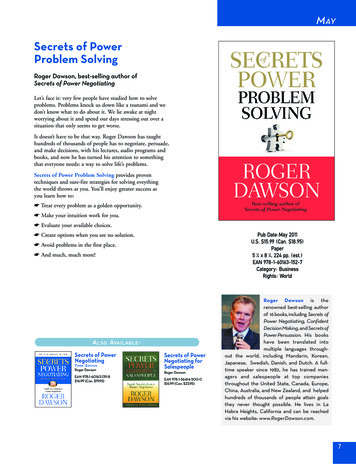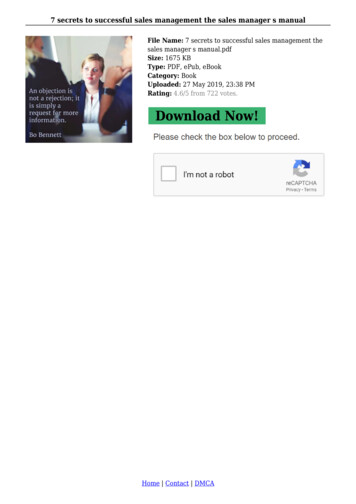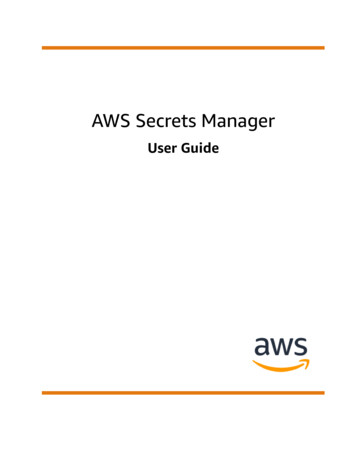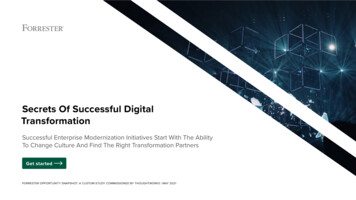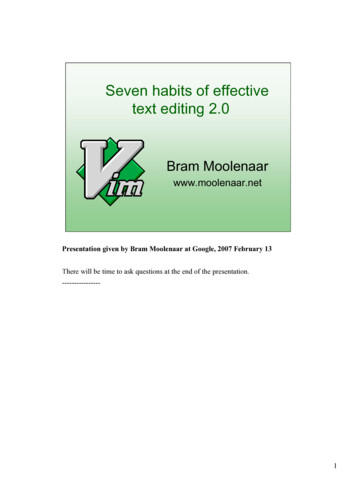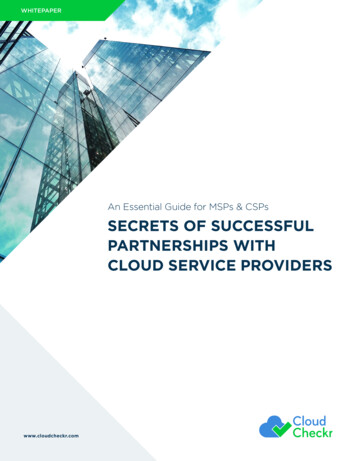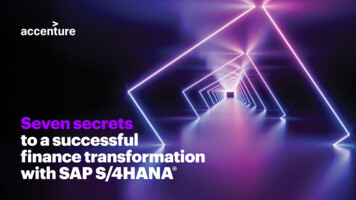
Transcription
Seven secretsto a successfulfinance transformation with SAP S/4HANA
Those who do not remember the past,runs a famous saying, are condemnedto repeat it. At this time of businessand technology disruption, it’s a goodlesson to bear in mind.2Finance transformation with SAP S/4HANA
It’s only been a few years since it became possible to conduct major finance transformationsbased on SAP S/4HANA . Already, however, we have had time to process experiencesfrom these first years and distill some important insights. When it comes to SAP-basedfinance transformation, three of those insights in particular are especially important:Business value needs to berealized at speedUsers must be more thanan afterthoughtUnderstand global andlocal requirementsThe pace of change is so great today thatno business can wait multiple years toshow a return on their IT investment. Ifa transformation program can’t deliverimmediate as well as interim value along theway, it’s a nonstarter. Business value must beclear, and the finance transformation projectmust continually drive toward that value.You can’t have your system go live afterdevelopment and then expect peoplejust to “adopt” technical and functionalchanges that are presented to them as a faitaccompli. Transformation programs todaymust begin and end with the user in mind.It is important to understand the globaland local complexities that companiesdeal with today—ever-changing regulatoryenvironments and external factors thatrequire a company to be flexible and resilientin the execution of their ERP roadmap.How can CFOs drive a finance transformation program toward business value, always keeping these lessons in mind?Based on Accenture’s experience from more than 300 SAP S/4HANA projects completed or in process, and the deployment of SAPS/4HANA Finance in more than 80 countries, here are seven secrets we’ve identified for a successful SAP-based finance transformation.Vision3RoadmapFinance transformation with SAP S/4HANAUsersDataAutomation & innovationGlobal vs. localGovernance
1. VisionEstablish a clear and shared vision for your financeorganization and relentlessly manage towards it.The vision should be a “north star,” remainingfixed regardless of what swirls around it.It guides a company and protects it frominevitable distractions and naysayers. Becauseit is fixed, it enables a company to managetoward a clear destination and measurevalue before, during and after the program.The vision is much more than a bumpersticker or a merely inspirational message.It’s supported by a detailed businesscase. When Accenture managed its ownfinance transformation a few years ago,which included an implementation of SAPS/4HANA in the cloud, a full business caseincluded strategic value levers, essentialrequirements and optional scope items.4Finance transformation with SAP S/4HANAIt also detailed the followingimplementation plan components: An integrated program plan depictingtimeline options with associatedprerequisites and dependencies Budget analysis, including onetime implementation and ongoingrun costs for solution options Resource, role and headcount projections Major risks and mitigations
2. RoadmapCreate a compelling and flexible implementation roadmapfocused on delivering value early and often.A roadmap is the “what, when, who, where and how” planning and guidance asset for the transformation. It includes the functional scope;technical landscape; timeline option and business cycles; users and business partners; global locations; and the deployment approach andgovernance structure. Major steps to create a finance transformation roadmap include:Create a wish list of improvementsand new capabilitiesEnvision improvements and innovations,along with what streamlined processes andtechnology could give you. Here you alsoidentify some “quick wins” to demonstratethe value of the transformation program tothe organization, top to bottom, and drivestakeholder excitement. You’ll need to movebeyond a monolithic release strategy toreleases per quarter or month so those quickwin ideas become a reality.5Finance transformation with SAP S/4HANAIdentify meaningful initiatives anddevelop an “unconstrained” roadmapStart by thinking big. Suppose for a momentyou had no budget, organization or businesstrade-off constraints. What would be possible?Add dependencies to the roadmapNow, it’s time to “get real.” Add in the financeand technology dependencies and resourceconstraints along with business continuityrisks. As you add these to the mix, focuson how many elements of the “think big”roadmap you can keep.Prioritize initiatives based on strategicimperatives and the need to maximizespeed-to-valueHere is where wisdom and experience reallycome in. You’ll have a combination of criticalimperatives that take quite a long time tocome to fruition, along with some imperativeswhere the impact is slightly less but can bedemonstrated quickly. Getting that mix rightis important.
3. UsersDesign processes and manage change withusers in mind. One aspect of user-centricthinking involves the user experience.With SAP S/4HANA, it is important to look athow people work and what is needed to helpusers get their job done, rather than rewritingexisting transactions with a new user interfacetechnology. SAP Fiori has significantlyadvanced companies’ ability to create a usercentric experience with their SAP system.It enables companies to complete the fullbusiness process from a single user screen, andthe end-user doesn’t need to move to differentapplications to perform any particular task.Another dimension of user-centricityinvolves a company’s ability to managepeople change effectively while the financetransformation is in process. This must bemore than an afterthought, or a low-budget6Finance transformation with SAP S/4HANAresponse with a few classroom-based trainingcourses. High percentages of businesstransformation programs fail to fully realizetheir business case objectives, in part becausethey neglected change management.An innovative change program from Accentureis Accenture Transformation GPS, which usesprescriptive analytics to auto-generate anoptimal transformation strategy. The multidimensional transformation map producedby Transformation GPS is based on 33 billioncalculations. It helps visualize exactly whereall critical stakeholder groups are and whatissues and dynamics need to be addressedso targeted interventions may be taken.
4. DataCreate an intelligent data framework. Don’t underestimate thevalue of good data and the effort involved to get it right.With any transformation, it’s importantto create a data strategy early on tounderstand the value of data for theorganization and then turn it into insights.To understand the data:Turning data into insights requires: Know your sources, integrationsand limitations Accurate financial statements you can trust Understand the breadth of internal andexternal (e.g., third-party) information Use automation and machinelearning to close data gaps Include local regulatory and statutory needs Capture tax detail previously inaccessible Financial KPIs that matter to your business Analytics that enable rapid decision-making A robust reporting strategy andarchitecture to make sure data is:- Easily found- Available when you need it- Secured and controlled7Finance transformation with SAP S/4HANA
5. Automation and innovationEmbed automation and innovation atthe heart of the program.Enrich the right processes in your SAPS/4HANA solution with artificial intelligenceand machine learning to accelerateprocessing, improve data accuracy andcreation, eliminate reconciliations andperform allocations in real time—all whilemaintaining continuous global regulatorycompliance and risk mitigation.8Finance transformation with SAP S/4HANAAutomation can include a range oftechnologies and approaches, from basicprocess automation (project-level, ad hocautomation for areas like scripts and macros)up to robotic process automation (RPA),cognitive RPA, virtual agents and machinebased process execution.
In terms of innovation, methods to encourage practical innovation and bring it to life must be plannedlike any other element of the transformation program. Programs that want to truly transform the financefunction should establish five innovation pillars at the start of the program and allocate investmentsbased on future benefits—not only on today’s needs:9GovernanceInspirationArchitecturePrioritize fit-to-standard,then innovate where it’spossible to differentiate.Enable a steady streamof ideas.Create an innovationreference architecture that isde-coupled , cloud-enabled,data-driven and flexible, toevolve as the transformationprogram evolves.WorkforceEcosystemEstablish a flexible andadaptive workforce;actively communicate andincentivize innovation.Build an innovationecosystem throughpartnerships and engagementwith industry forums.Finance transformation with SAP S/4HANA
6. Global vs. localManage according to both global and local complexities.Finance transformation at a global scale iscomplex, to say the least. Every project needsto determine, document and socialize its owndefinitions of global and local requirements.Typically, “global” refers to commoncomponents and processes, while “local”designates legal and statutory requirementsby country, along with contractual, industryregulatory, or local business practices.The “golden template” includes commoncomponents and processes, including: Business process models andbusiness blueprint for globalprocesses and integration flows Technology blueprint, includingthe technical architecture, dataintegration layer and standards Fully integrated data model, definition ofcore master data and transactional data Reporting approach and architecture Roles and authorizations, controlsand compliance framework10 Finance transformation with SAP S/4HANALocal requirements should be evaluatedat the beginning of the global programand accounted for prior to global templatedesign so that they can be embeddedinto the template. Additional specificlocal requirements can be promoted tothe global level during deployments oras needed, though upfront planning isneeded to avoid costly template retrofits.
7. GovernanceEstablish strong governance for decision-making.Governance is critical to supportingeffective decision-making. It also enablescompanies to control the scope of thetransformation, ensuring that the solutionand key participants are aligned to theoriginal vision that was established.Two types of governance are needed for afinance transformation program: programgovernance and solution governance.Program governance sets forth and managesways of working for effective decisionmaking and escalations. It includes decisionsabout program structure and ultimatecontrol of timeline, scope and budget. Itoversees management changes on timelines,scope and budget, as well as alignment onteam structure, roles and responsibilities,commercials, and status templates.11Finance transformation with SAP S/4HANASolution governance makes ongoing decisionsto build the global design for the financetransformation program and deploy it acrossunits, and across process, data and technology.Solution governance also makes sure that thedesign meets legal, regulatory, statutory andcompliance requirements. Keys to success hereare to adopt standard and leading practicesand eliminate customizations whereverpossible, and to ensure process harmonizationacross regions and business segments.
Sharing the secretsFinance transformations leveraging SAP S/4HANAneed to be planned and executed with a company’sbroader strategic goals in mind.Most secrets you don’t want to share, butthe seven secrets discussed here need tobe well-known across your entire globalorganization, from decision-makers andbudget-holders to front-line workers. Formany organizations, this is a once-in-a-lifetimechance to transform their finance function.12Finance transformation with SAP S/4HANAWith SAP S/4HANA, companies can gaina significant business advantage with anintelligent, next-generation ERP system. Thesystem combines financial, managerial andoperational data in a unified, in-memorysystem that accelerates performance withreal-time processes and analytics deployedin the cloud, on premise, or in a hybridmodel. The result is a solid digital corefoundation ready to not only support butaccelerate a company’s growth strategy.CFOs have long been responsible foraccounting for the past and managingtechnology investments. Today, however, theyare looking to increasingly harness the powerof data to enhance their value to the business.They are also looking well beyond the bordersof the finance function, proposing and shapingbusiness models across the enterprise, and,ideally, leading the charge in guiding theirorganization through the digital revolution.
About AccentureAccenture is a global professional servicescompany with leading capabilities in digital,cloud and security. Combining unmatchedexperience and specialized skills acrossmore than 40 industries, we offer Strategyand Consulting, Interactive, Technologyand Operations services — all powered bythe world’s largest network of AdvancedTechnology and Intelligent Operationscenters. Our 537,000 people deliver on thepromise of technology and human ingenuityevery day, serving clients in more than 120countries. We embrace the power of changeto create value and shared success for ourclients, people, shareholders, partners andcommunities. Visit us at www.accenture.comAbout the authorConstantin HolznerManaging DirectorAccentureLearn moreTo find out more on how Accenture can supportyour finance transformation, visit our webpage for SAP-based finance transformationCopyright 2021 Accenture.All rights reserved.Accenture and its logo are trademarks of Accenture.200524
10 Finance transformation with SAP S/4HANA 6. Global vs. local Manage according to both global and local complexities. Finance transformation at a global scale is complex, to say the least. Every project needs to determine, document and socialize its own definitions of global and local requirements. Typically, "global" refers to common
